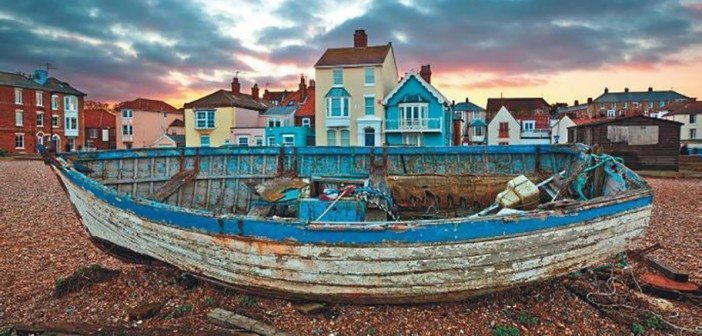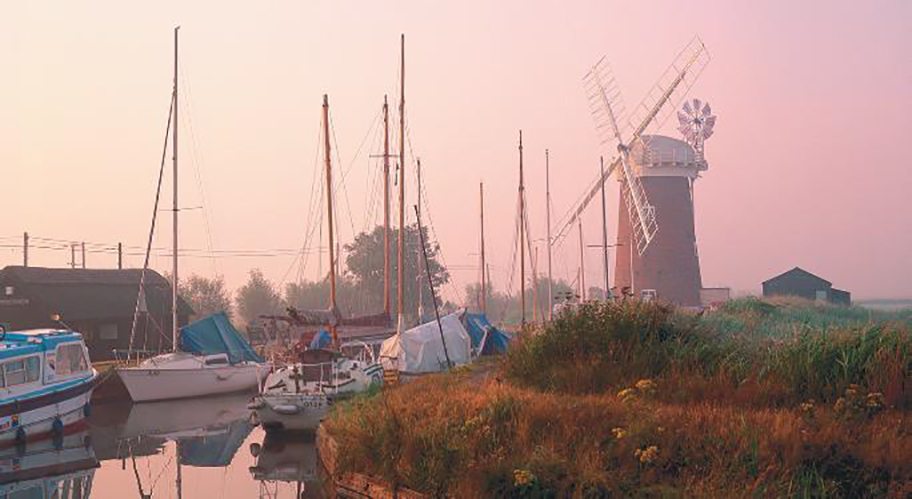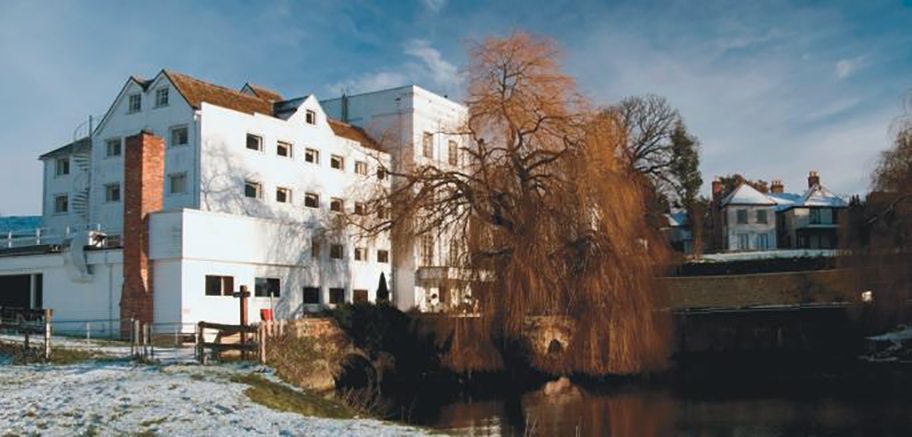
Hidden villages and sweeping vistas, windmills and waterfowl, tiny stone churches and verdant undulating countryside: let's explore Suffolk.
Tucked in a corner of East Anglia under the famous painters' sky, this ancient Saxon county is little visited by Americans, remains blessedly free from hoards of tourist coaches, and beckons for discovery. This is quintessential English countryside and a delightful pastoral ramble through its history and landscape. There's color and variety—without the crowds.
DAY 1: It's an Easy Drive into East Anglia
From London or the airports, at Junction 28, the M25 ring road meets the A12, leading northeast across Essex. An hour or so drive takes you past Chelmsford to Colchester (with its Roman sites if you've time to explore). Take the A134 another 15 miles to the pretty south Suffolk market town of Sudbury on the River Stour. Dating from Saxon times, Sudbury has three medieval churches to explore. Hometown of Thomas Gainsborough, the artist's birthplace is a museum of his life and painting. The 3-star Legacy Mill Hotel harks back to Sudbury's prosperous past in the weaving industry. This makes a great place to begin exploring the Saxon county of the “South Folk.”
Read more
DAY 2: Excursion to Bury St. Edmunds and Newmarket
Take an excursion today into Suffolk's history. Nearby villages of Lavenham and Long Melford are renowned for their antique shops. Lavenham is often termed the quintessential medieval village. Route up the A134 a dozen miles to the small cathedral city locals term BSE to visit St. Edmundsbury Cathedral in Bury St. Edmunds; check out the lovely abbey gardens and the Martyrs Memorial in the adjoining cemetery. Dickens used to stay at the Bull Hotel across the square; oddly enough, so did Mr. Pickwick and friends. West on the A14, a short drive is Newmarket, the hometown of English horseracing, the National Stud, and the jockey museum. In the morning, you can watch the thoroughbreds being put through their paces on the gallops. Or turn east on the A14 to Stowmarket and a visit to the Museum of East Anglian Life. It is an easy drive threading through Suffolk farmland back to Sudbury for the evening.
DAY 3: Constable Country to Aldeburgh
Follow the River Stour east this morning into Constable Country. The B1068 leads to Dedham Vale, East Bergholt, and Flatford Mill, the haunts and scenes captured so tellingly by English landscape painter John Constable. The A37 leads a few miles north to the harbor town of Ipswich, with its classic English waterfront. Ipswich's key visit is Christchurch Mansion, a Tudor brick manor set in 70-acre Christchurch Park. Admission is free to its fine period rooms reflecting 500 years of history, as well as art galleries containing the largest collection of Constable and Gainsborough paintings outside of London, and the work of acclaimed Suffolk artists Alfred Munnings and Camille Pissaro.
Carry on north this afternoon following the A12, the main Suffolk coast road, to the seaside town of Aldeburgh. There are plenty of accommodation options. One moderately-priced classic is the friendly Wentworth Hotel just a yard off the shingle beach.
DAY 4: Thorpeness, Leiston Abbey and Snapes Malting
Aldeburgh is a fine town to explore. Famed for its association with composer Benjamin Britten, Aldeburgh retains a gentle charm, where fishing boats pull up on the pebble beach and sell their North Sea catch straight from the boat. It's a great day for exploring some of that weird Suffolk coast (see p. 26). Just a mile or so up the coast is Thorpeness—and the House in the Clouds. Visit the monastic ruins of Leiston Abbey and explore Snapes Malting, home of the prestigious Aldeburgh Festival originated by Britten.
The old repurposed malt houses also feature shops and eateries in a picturesque river setting. There's no shortage of those in Aldeburgh either.

DAY 5: The Coast Road to Lowestoft
Heading north this morning on the A12, you will find the North Sea is always a detour of a mile or so to the east. Our route largely follows John Wade's narrative a few pages on. The distances are short, so there's no rush to the day. Dunster is really worth a look: England's Atlantis, disappearing into the sea over the centuries. Do stop and visit magnificent Holy Trinity Church in Blythburgh, “the Cathedral of the Marshes.” Southwold is a star, renowned for those colorful beach huts. If time and interest direct, take a tour of Adnam's brewery, fount of Suffolk's most famous beer. It's also a lovely place to wander around the shops and have a late lunch. The Suffolk Wildlife Park lies further on in Kessingland, just south of Lowestoft. Suffolk and its adventures end here. Easternmost town in Britain, Lowestoft is a classic seaside resort of 60,000. Its harbor is a gateway into the network of navigable waterways and rivers that thread through the fenland of eastern Norfolk known as The Broads.

DAY 6: On to Norfolk?
From Lowestoft, it is a morning's drive back to the M25 and London. If travel time permits, however, take a boat for a few days on the Norfolk Broads; The A12 follows on north to Great Yarmouth, and the A146 crosses Broadland in under an hour to the historic and beautiful medieval cathedral city of Norwich. As always traveling in Britain, we are only spoiled for choice.
* Originally published in Dec 2014.





Comments